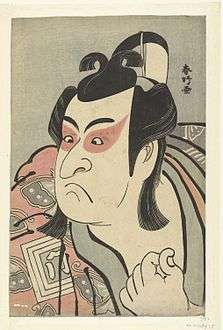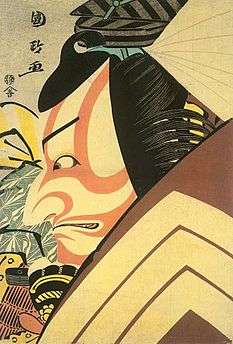Kabukidō Enkyō
_Sandaime_Ichikawa_Yaoz%C5%8D.jpg)
Kabukidō Enkyō (歌舞伎堂 艶鏡, fl. c. 1796) was a Japanese ukiyo-e artist. Only seven of his works are known, all of which are ōkubi-e bust portrait prints of kabuki actors. Scholars divide them into two groups based on differences in the signatures; the second group appears to be a set, as they depict three brothers from the same play. Enkyō's identity has been subject to speculation: a student of Sharaku's, even Sharaku himself, or a kyōgen playwright.
Works
Enkyō appears not to have been a prolific artist. Seven portraits were confirmed as Enkyō's in the early 20th century, and no further works have been discovered.[1] The ōban-size[lower-alpha 1][2] yakusha-e woodblock print portraits of kabuki actors are all ōkubi-e bust portraits dated to c. 1796. None bear a publisher's seal. Scholars divide them into two groups based on differences in the artist's seal. The first group bears the seal "Kabukidō Enkyō Ga" (歌舞伎堂艶鏡画) and is made up of:
- Ichikawa Omezō I (初代市川男女蔵 Shodai Ichikawa Omezō)
- Ichikawa Yaozō III (三代目市川八百蔵 Sandaime Ichikawa Yaozō)
- Sawamura Sōjūrō III (三代目沢村宗十郎 Sandaime Sawamura Sōjūrō)
- Nakayama Tomisaburō I (初代中山富三郎 Shodai Nakayama Tomisaburō).
- Actor portraits by Kabukidō Enkyō
_Ichikawa_Omez%C5%8D_I.jpg) Ichikawa Omezō I
Ichikawa Omezō I_Sandaime_Ichikawa_Yaoz%C5%8D.jpg) Ichikawa Yaozō III
Ichikawa Yaozō III_Shodai_Nakayama_Tomisabur%C5%8D.jpg) Nakayama Tomisaburō I
Nakayama Tomisaburō I
_Shosei_Ichikawa_Omez%C5%8D_no_Yakko_Ippei.jpg)
Ichikawa Omezō I portrays a character from the kabuki play Sumida no Haru Geisha Katagi[lower-alpha 2] (1796).[3] Enkyō's depiction of the warrior-like character invites comparison to Sharaku's portrait of the same, though they achieve different effects.[1] Sharaku's has greater depth of expression, while Enkyō's simpler, more greatly exaggerated depiction with larger eyebrows leaves a strong immediate expression.[3] Enkyō gives his Omezō a fecetious expression and delineates his rounder features with a milder line.[1] He colours the irises with thinned sumi ink, a technique Enkyō may have borrowed from Shun'ei, Toyokuni, and Kunimasa, who had introduced it about that time.[2] Evidence of the effort put into the design can be inferred from other fine details such as touches of red on the earlobes and the colouring on the shaved part of the forehead.[1]
It has been suggested the Ichikawa Yaozō III portrait is of a key character in the play Katakiuchi Noriyaibanashi[lower-alpha 3] (1794). It uses thinned ink to colour the irises, and the composition appears to bear the influence of Sharaku in its attempt at relatively greater realism. The positioning of Enkyō's Nakayama Tomisaburō I, with the actor's hand on his collar, bears strong resemblance to Sharaku's of the same in the role of Miyagino from Katakiuchi Noriyaibanashi, suggesting Enkyō likely used Sharaku's print as a reference.[4]
The other three appear to make a set.[5] This set shows a stronger Toyokuni influence, rather than Sharaku; while basically striving for realism, there is an idealizing tendency in the rendering of the facial expressions.[1] The prints depict actors in the roles of three brothers from the "Kuruma-biki" (「車引」) episode[1] of the play Sugawara Denju Tenarai Kagami (1796).[5] The scene depicts Umeōmaru and Sakuramaru waiting in ambush for Fujiwara no Shihei. Their brother Matsuōmaru, who is loyal to Shihei, foils their plot.[1] The Nakamura Noshio II has no seal, and the other two bear the seal "Kabukidō Ga" (歌舞伎鏡画). The set is made up of:[5]
- Nakamura Nakazō II as Matsuōmaru (二代中村仲蔵の松王丸 Nidaime Nakamura Nakazō no Matsuōmaru)
- Ichikawa Yaozō III as Umeōmaru (三代市川八百蔵の梅王丸 Sandaime Ichikawa Yaozō no Umeō)
- Nakamura Noshio II as Sakuramaru (二代中村野塩の桜丸 Nidaime Nakamura Noshio no Sakuramaru)
- Portraits from Sugawara Denju Tenarai Kagami by Kabukidō Enkyō
.jpg) Nakamura Nakazō II as Matsuōmaru
Nakamura Nakazō II as Matsuōmaru_Sandaime_Ichikawa_Yaoz%C5%8D_no_Ume-%C5%8Cmaru.jpg) Ichikawa Yaozō III as Umeōmaru
Ichikawa Yaozō III as Umeōmaru.jpg) Nakamura Noshio II as Sakuramaru
Nakamura Noshio II as Sakuramaru
The second print of the set Nakamura Noshio II as Sakuramaru depicts the youngest of the three brothers, a romantic character whose symbol is the sakura cherry blossom. The character was sometimes performed by an onnagata, an actor specializing in female roles.[1]
Many have seen Enkyō's work as being the closest in style to Sharaku,[1] whose short career spanned ten months in 1794–95. Others have seen the similarities as superficial and point to differences in technique and psychology of the subjects. These scholars have suggested Enkyō's approach may be closer to that of Shunkō's,[6] Shun'ei's, Toyokuni,[1] or Kunimasa's.[7]
- Comparison to actor portraits by similar artists
 Ichikawa Monnosuke II, Shunkō, 1789
Ichikawa Monnosuke II, Shunkō, 1789 Ichikawa Komazō II, Sakata Hangōrō III, Nakayama Fukasaburō I, Shun'ei, 1794
Ichikawa Komazō II, Sakata Hangōrō III, Nakayama Fukasaburō I, Shun'ei, 1794 Ichikawa Ebizō, Kunimasa, 1796
Ichikawa Ebizō, Kunimasa, 1796 Ichikawa Komazō II, Toyokuni, 1797
Ichikawa Komazō II, Toyokuni, 1797
Identity
Enkyō's identity is uncertain.[6] There is a brief mention of him in the Ukiyo-e Ruikō, the earliest collection of commentaries and biographies on ukiyo-e artists, begun c. 1790 by Ōta Nanpo (1749–1823). Its single line mentions him as a portraitist who lasted merely half a year, and omits the name Enkyō.[lower-alpha 4][8]
Some have seen Enkyō as a student and perhaps the sole successor of Sharaku.[6] The German writer Julius Kurth asserted Enkyō was Sharaku, who had assumed a new identity to revive his career.[9] The American Arthur Davison Ficke called this idea "an alluring but somewhat fantastic theory, which neither the documentary nor the internal evidence ... adequately supports",[7] and James A. Michener agreed this was a "fanciful theory ... but nothing in the artistic content of Kabukidō's prints supports this wild guess", though "some of Sharaku's later triptychs ... are occasionally as dull as known Kabukidōs".[10] Another theory, using "Morellian" techniques comparing minor details of works, posits that eleven of Sharaku's third-period works can be attributed to the hand of Enkyō.[9] In 1926 ukiyo-e scholar Naonari Ochiai declared he was the kyōgen playwright Nakamura Jūsuke[lower-alpha 5] (1749 – 4 November 1803).[6] In such a case, it may be that his work was but the hobby of an amateur, and lacks a publisher's seal due to having been printed as a special commission.[1] Ōta Nanpo was an acquaintance of Nakamura Jūsuke's, and his writings leave no mention of such a connection.[8]
Notes
References
- 1 2 3 4 5 6 7 8 9 10 11 Nihon Ukiyo-e Kyōkai 1981, p. 42.
- 1 2 Nihon Ukiyo-e Kyōkai 1981, pp. 42–43.
- 1 2 Gotō 1973, p. 133.
- ↑ Nihon Ukiyo-e Kyōkai 1981, p. 43.
- 1 2 3 Kokusai Ukiyo-e Gakkai 2008, p. 139.
- 1 2 3 4 Yoshida 1994, p. 171.
- 1 2 Ficke 1917, pp. 317–318.
- 1 2 3 Katō 1998, p. 10.
- 1 2 Matsuki 1985, p. .
- ↑ Michener 1954, p. 181.
Works cited
- Ficke, Arthur Davison (1917). Chats on Japanese Prints. Frederick A. Stokes Company. OCLC 462667666.
- Gotō, Shigeki, ed. (1973). Ukiyo-e Taikei 浮世絵大系 (in Japanese). 7. Shūeisha.
- Katō, Yoshio (1998-01-10). "Ōta Nanpo ga kakitometa ukiyo-e-shi-tachi" 大田南畝が書き留めた浮世絵師達. Ukiyo-e Geijustsu (in Japanese) (126): 3–45.
- Kokusai Ukiyo-e Gakkai, ed. (2008). Ukiyo-e daijiten 浮世絵大事典 (in Japanese). Tōkyōdō Shuppan. ISBN 978-4-490-10720-3.
- Michener, James Albert (1954). The Floating World. University of Hawaii Press. ISBN 978-0-8248-0873-0.
- Matsuki, Hiroshi (1985). "Sharaku no nazo to kagi" 写楽の謎と鍵. In Tsuji, Nobuo. Sharaku 浮世絵八華. 4, 写楽. Ukiyo-e hakka (in Japanese). 4. Heibonsha. ISBN 4-582-66204-8.
- Nihon Ukiyo-e Kyōkai, ed. (1981). Genshoku Ukiyo-e Dai-hyakkajiten 原色浮世絵大百科事典 (in Japanese). 8. Taishūkan Shoten. OCLC 8327141.
- Yoshida, Teruji, ed. (1994). Ukiyo-e Jiten 浮世絵事典 (in Japanese). 1. Gabundō. ISBN 978-4-87364-004-4.
External links
-
 Media related to Kabukidō Enkyō at Wikimedia Commons
Media related to Kabukidō Enkyō at Wikimedia Commons